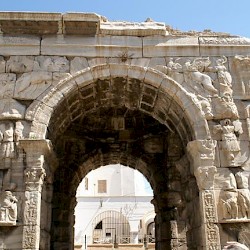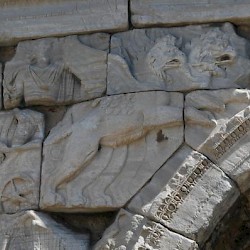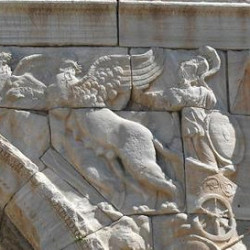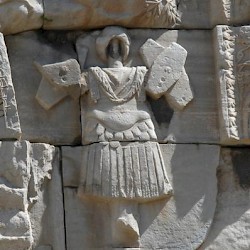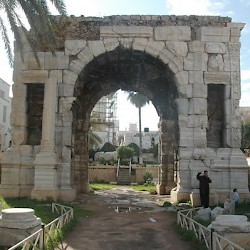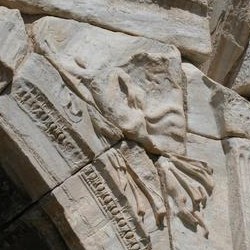Oea, Arch of Marcus Aurelius
Q3621785Oea (Punic W'jt): Roman city in Libya, modern Tripoli. The Arch of Marcus Aurelius is the main surviving monument.

The only monument in Oea that is still visible, is the so-called Arch of Marcus Aurelius. It actually commemorates the victories of Marcus' brother Lucius Verus. In 161, the Parthian king Vologases IV had unexpectedly attacked the Roman empire and annihilated a legion, probably the Ninth Hispana. Lucius Verus led the counter-attack, which lasted several years, but culminated in the sack of the Parthian capital Ctesiphon.
There were many monuments to commemorate this victory, like the Parthian Monument in Ephesus. That the arch in Oea was erected in 165, can be deduced from the emperors' style of titles, which calls them Armeniacus, a name they had accepted in the preceding year; the titles Medicus and Parthicus, which were added in 166, are still absent.
The corners of the monument are directed to the four points of the compass, and the four façades are directed to the northwest, northeast, southeast. and southwest. The northwest face is the best preserved. You must imagine a gilded statue of the emperors in a chariot on top if it. All this is very common.
The decoration itself, however, is not, because it contains mythological symbols, like these griffins (winged lions with the head of an eagle). You will not find them in the spandrels of the Arch of Titus, the Arch of Septimius Severus, or the Arch of Constantine in Rome. Here, the griffins are shown in front of Lucius Verus' triumphal chariot.
Opposite the emperor, there are sphinxes, this time in front of the chariot of the goddess Roma, the personification of the eternal city. The inscription mentions that the monument was erected by a local magistrate (IIvir) named Gaius Calpurnius Celsus, dedicated to the emperors, and that the proconsul of Africa, Sergius Cornelius Scipio Salvidienus, and his legatus Vittedius Marcellus were also involved.
The main arches were to the northeast and southwest. In the niches, statues must have stood; one of them was found and tentatively identified with Lucius Verus. This suggests that there must have been a statue of Marcus Aurelius as well; the other two cannot be identified. Above the four statues were four medallions, which probably represented the four seasons. On the arch's southeast façade, prisoners of war were shown. They are now badly damaged.
